ABSTRACT
Eastern Democratic Republic of Congo constitutes an area where the East African Highland bananas (Musa-AAA-EA) and plantains (Musa-AAB) meet. However, Musa diversity in this region has never been characterized nor represented in national or international collections, yet increasing human activities and build-up of pests and diseases, especially Xanthomonas wilt of banana and banana bunchy top disease, could negatively affect this diversity. This study assessed, collected and morphologically characterized on-farm Musa diversity in the North Kivu and Ituri provinces. Musa accessions collected were added to the UCG-Butembo in situ field collection. A total of 90 and 150 farms were assessed, respectively, in the North Kivu and Ituri provinces. High Musa variability was observed in both provinces. Forty-one cultivars (six presumed new) were identified in Ituri Province compared to 38 cultivars (13 presumed new) in North Kivu Province. Nineteen cultivars occurred in both provinces. Beni and Lubero territories in North Kivu and Mambasa territory in Ituri Province had greater Musa diversity, varying between 27 and 38 cultivars, approximately double of the number of cultivars observed in the other territories. Twenty-three of the 34 Musa descriptors contributed more to the discrimination of the cultivars identified across the provinces and were therefore used for grouping the cultivars using principal component analysis (PCA). The Morisita index of similarity between Ituri Province and North Kivu Province territories was less than 0.5, suggesting dissimilarity in diversity between these sites. Six cultivars: ‘Kirisirya’, ‘Pakuma’, ‘Nziravahima’, ‘Vuhindi’, ‘Tundu’ and ‘Kisubi musa’ were reportedly at risk of genetic erosion.
Key words: Banana, conservation, cultivars, ex-situ, genetic erosion, genotypes, plantain.
Bananas and plantains (Musa spp.) are an important staple and income-generating crop for millions of people in the tropical and subtropical regions of the world (Robinson and Galán Saúco, 2010). Over 70 million people in the Great Lakes region of Africa rely on banana and plantain, which provide at least 25% of their daily carbohydrate intake (Frison and Sharrock, 1999). In Eastern Democratic Republic of Congo (DR Congo), the per capita consumption of Musa spp. is about 200 kg/yr (Ndungo, 2004) and it contributes nearly 70% of total crop production, with 23.5% of the production realized in the North Kivu Province (Bakelana and Ndungo, 2004).
The Congo Basin and the neighbouring countries of the Gulf of Guinea are secondary centres of diversification of plantain (Musa AAB) while the East and Central African countries are secondary centres of diversification of highland cooking and brewing banana (Musa AAA-EA) (Swennen et al., 1995). Eastern DR Congo constitutes an exceptional area where the East African Highland bananas (AAA-EA genome) and plantains (AAB genome) meet. This exceptionally high Musa diversity is attributed to the presence of three agro-ecological zones characterised by high, medium and low altitude sites (Ndungo, 2002; Ocimati et al., 2013b). However, Musa diversity has been reported to be eroding in the centres of origin (including DR Congo) because of human development activities, land pressure, pests and diseases, market demands and civil unrest (Okech et al., 2002, 2005; Nsabimana and van Staden, 2005; Doré and Varoquaux, 2006; Ndungo et al., 2008; Ocimati et al., 2013a, b, 2014). For example, the region also experienced armed conflicts for over three decades, resulting in population migrations and abandonment of banana fields. Nsabimana and van Staden (2005) reported similar population migrations in Rwanda to result in the disappearance or retaining of some Musa cultivars (with resultant confusion in the nomenclature). Musa production and diversity is currently also under high pressure due to plant nutritional problems and various pests and diseases (especially the Xanthomonas wilt of banana (XW) disease and banana bunchy top disease) (Okech et al., 2002, 2005; Ocimati et al., 2013a, 2014). For example, XW has devastated many plantations in the region, with farmers abandoning the crop for alternatives such as cassava, taro, legumes and sweet potato (Ocimati et al., 2016a, b). In addition, the combination of easy vegetative propagation and a slow breeding process due to meiotic failures during gametogenesis (Ortiz et al., 1995; Vuylsteke et al., 1995) increases the vulnerability of the Musa crop. This has resulted in a very limited genetic diversity within the African plantain and East African Highland banana cultivars (Noyer et al., 2005; Kitavi et al., 2016), further exposing the crop to the risk of genetic erosion. Musa genetic erosion could potentially also be worsened by climate change.
This study therefore sought to understand the Musa diversity in the North Kivu and Ituri provinces, morphologically characterize it and conserve new genotypes in the Butembo provincial Musa collection for purposes of Musa crop improvement and development.
This study was conducted through a diagnostic Musa germplasm survey that sought to collect and characterize all local cultivars present in the North Kivu and Ituri provinces of Eastern DR Congo. North Kivu lies on the equator between latitude 0° 58' North and 02° 03' South, and longitude 27° 14' and 29° 58' East and is bordered to the East by Rwanda and Uganda, North and West by Ituri Province, South West by Maniema Province, and South by South Kivu Province. Whereas, Ituri Province is located in the North-Eastern part of DR Congo between latitude 1° and 3° 40' North and longitude 28° and 31° 15' East. It is bordered to the North, East, South and West respectively, by South Sudan, Uganda, North Kivu and Haut-Uélé provinces, and Tshopo Province. All territories in North Kivu Province (that is, Beni, Lubero, Masisi, Nyirangongo, Walikale and Rutshuru) and Ituri Province (that is, Aru, Djugu, Irumu, Mahagi and Mambasa) were initially targeted for this study. However, only three territories in North Kivu (Beni, Lubero and Rutshuru) were accessible due to insecurity in the other territories.
North Kivu enjoys a wide variability in climatic conditions. It has two wet seasons (mid-August to mid-January and mid-February to mid-July) and two short dry seasons (mid-January to mid-February and mid-July to mid-August) and a mean annual rainfall between 1,000 mm (lowest altitudes) and 3,170 mm (at high altitude areas). Its mean annual temperature varies between 15 and 30°C and an altitude range from 800 to 5,119 m a.s.l. (top of Mount Rwenzori) (Ndungo, 2002; DRC, Ministry of Planning, 2005). It also has a high variability in the soils, with volcanic soils between Goma and Rutshuru; alluvial soils between the plains of the Rutshuru and Semliki River; and naturally weathered deep and humus rich rock soils (DRC, Ministry of Planning, 2005). North Kivu has a rich ethnic composition consisting of the Nande, Lese, Watalinga and Batwa (pygmies) in Beni territory; Nande, Piri and Batwa in Lubero; and the Hutu, Tutsi, Hunde and Nande in Rutshuru (DRC, Ministry of Planning, 2005).
Ituri has an area of 65,659 km2 (2.79% of the National territory). It has a mean altitude of about 1000 m a.s.l., with its elevation increasing from West (Congo basin; as low as 700 m a.s.l.) to East (Semiliki River and Lake Albert depression; as high as 2420 m a.s.l.). Of the 65,659 km2, 63,000 km2 of Ituri Province is occupied by an equatorial forest (Ituri forest), an area varying between 700 to 1,000 m a.s.l. This region is humid (85% relative humidity) with a mean temperature of 31° (Wilkie, 1987). Ituri Province consists of at least seven ethnic groups, the most important of which are Alur (24%), Lendu (22%), Lugbara (15%), Hema (13.6%) and Babira (12%). Others include Bombo 0.31%; Bandaka 0.31% and Batwa (Maindo, 2003). Aru territory is inhabited by Lugbara and Alur; Djugu by Gegere, Lendu, Alur, and Hema; Irumu by the Hema, Lese and Lendu; Mahagi by Alur; and Mambasa by Lese, Bira and Batwa (Saint Moulin, 2006).
The territories of Beni, Aru and Irumu comprise Beni,Aru and Bunia townships (Saint Moulin, 2006), with each having large markets. In each territory, three villages, giving a total of 24 villages, were purposively selected based on Musa production levels and diversity (Figure 1). In each village, a focus group discussion was conducted with at least 20 men and 20 women in separate groups to list the different banana cultivars grown and their local names. This gave a quick impression of the banana diversity within the villages. Focus groups also identified cultivars that had been lost from the Musa genepool and gave possible reasons for this genetic erosion. Only farmers with at least 20 mats in their fields were selected for field quantification of Musa diversity and characterization. Ten farms per village, totalling 240, were identified for this study.
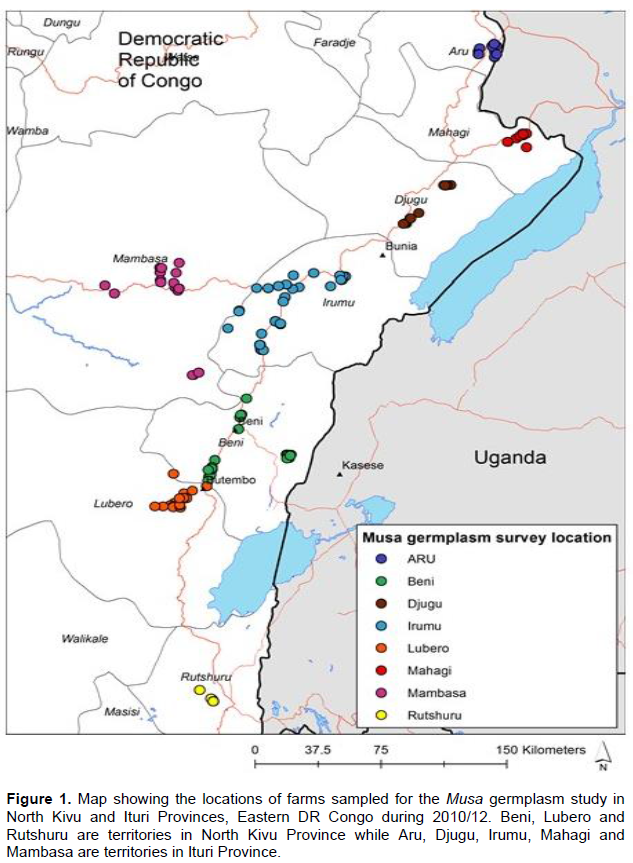
In each field/farm, an interview was conducted to gather information on the different cultivars grown and the cultivar synonyms; the respective quantities (mats per cultivar) were recorded. Cultivars identified in the fields were characterized morphologically using the 34-minimum set of descriptors for banana (IPGRI-INIBAP/CIRAD, 1996; MusaNet, 2011). Names of cultivars absent from the checklist of cultivars in the provincial collection at Université Catholique du Graben (UCG), North Kivu Province, DR Congo, were presumed new and their suckers were subsequently collected and planted at the UCG Musa collection for further characterization and conservation. GPS coordinates of the sampled fields and presumed new cultivars were recorded for mapping using Geographic Information System (GIS) software.
Morisita’s index of similarity was used to measure the similarity or dissimilarity between the sampled communities (Morisita, 1959; Hammer et al., 2008). This index is a good measure of niche overlap. It varies from 0 (no similarity) to 1 (complete similarity). The Morisita index of similarity is nearly independent of sample size, except for samples of very small size. Wolda (1981) recommended Morisita's index as the best overall measure of similarity for ecological use. PAST - PAlaeontological STatistics, ver. 1.77 statistical software (Hammer et al., 2001, 2008) was used to generate the Morisita similarity indices and to generate clusters showing similarity or dissimilarity in cultivar composition between the eight studied territories. Cultivar similarity groupings based on the 34 minimum descriptors were also generated using NTSYSpc (Numerical Taxonomy and Multivariate Analysis System version 2.21) (Rohlf, 2009). MS Excel was used to generate the graphs and histograms.
This study sought to explore Musa diversity in the North Kivu and Ituri provinces, morphologically characterize it and conserve newly identified Musa cultivars in the Butembo provincial Musa collection for purposes of Musa crop improvement and development.
Musa diversity
A high Musa diversity was uncovered across the two provinces despite pockets of the provinces were un-reachable due to presence of armed insurgents. Plantains were dominant in Ituri while cooking AAA-EA dominated the North Kivu. Thirty-eight Musa cultivars were collected from farmers’ fields in North Kivu Province (9 plantains (Musa AAB), 14 cooking (Musa AAA-EA), 8 dessert (AAA and AAB) and 7 brewing (ABB and AAA-EA cultivars), while 41 cultivars (26 plantains, 8 cooking, 4 dessert and 3 brewing) were collected in Ituri Province (Table 1). Nineteen cultivars were the same in both provinces (6 plantains, 6 cooking, 4 dessert and 3 brewing) (Table 1). Plantain cultivars represented 59.4% (14.4% French type, 44.5% false horn and 0.5% True horn) of Musa diversity in Ituri compared with 29.8% (21.6% French and 8.1% False horn and 0.1% True horn) in North Kivu (Table 2). East African Highland cooking cultivars (AAA-EA) were predominant in North Kivu (34%) compared with 19% in Ituri (Tables 1 and 2). The predominance of plantains in Ituri is due to its agro-ecology, characterized by a low mean altitude of about 1000 m a.s.l., high rainfall and temperature that provide humid conditions suitable for plantain production. Plantains grow well under humid conditions characterized by high rainfall and high temperature conditions (Sebasigari, 1985). In contrast, North Kivu Province has three agro-ecological zones characterised by low, medium and high altitudes that promote the diversity of both plantains and highland banana cultivars (Ocimati et al., 2013b), with the mid-high supporting AAA-EA cooking and beer cultivars, while the low altitude and humid areas supporting plantains. However, the observed Musa diversity in North Kivu could still be less than the full diversity of Musa in this region, since only three of the six sampled territories in North Kivu were accessible due to the presence of armed conflict.
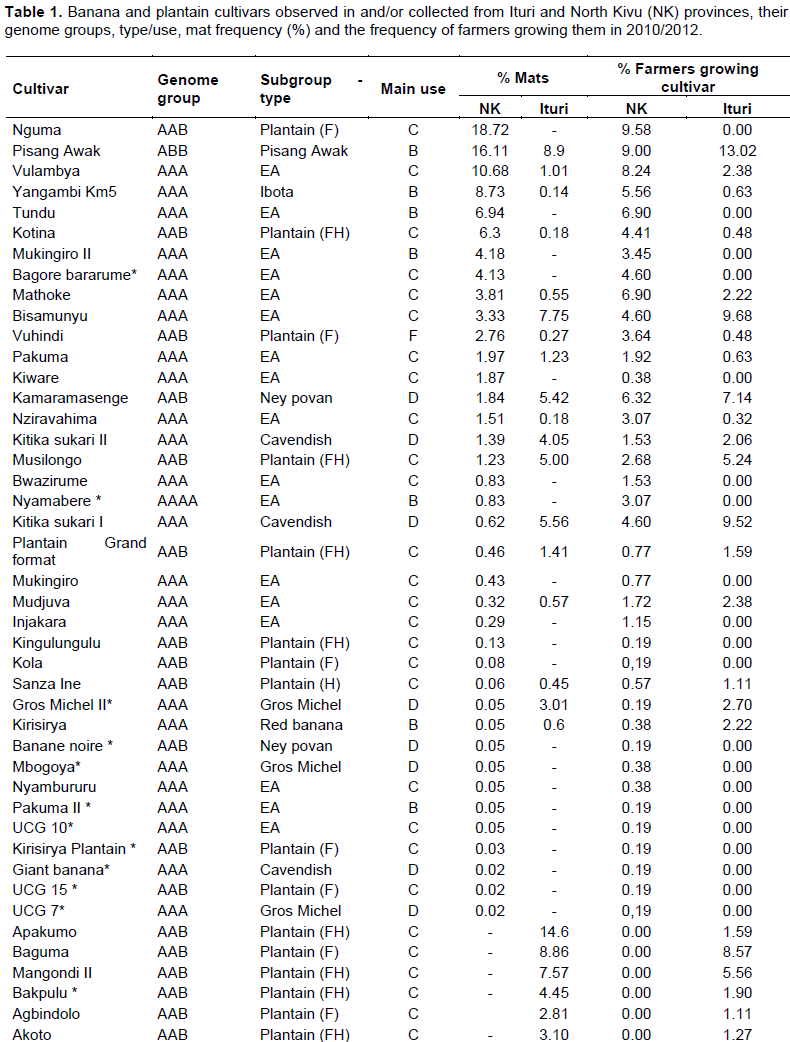
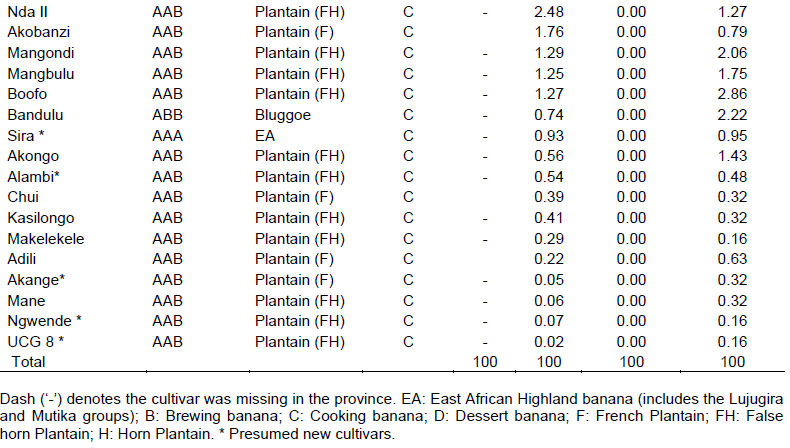
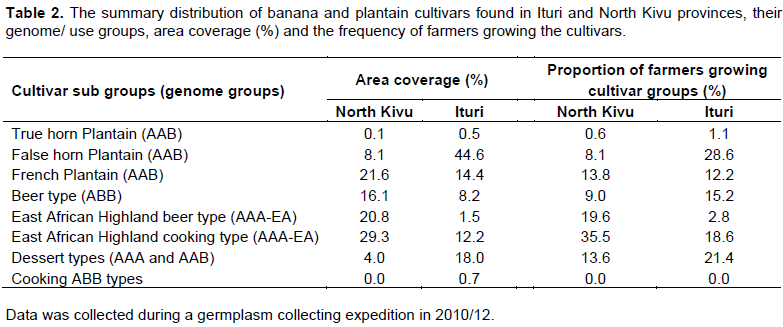
In North Kivu, the plantain ‘Nguma’ (19% of the sampled Musa area and grown by 10% of the sampled farms) was the dominant cultivar (Table 1). This can be attributed to its large bunch size and high cost in the market per the report of farmers interviewed and key informants. ‘Kotina’ (6% of the Musa area, 4% of farms) was the second most cultivated plantain cultivar in this region. Overall, the brewing cultivar ‘Pisang awak’ (ABB-genome, 16% of landscape, 9% of farms and known as ‘Kisubi Musa’), was the second most important cultivar. For a given bunch weight, ‘Pisang awak’ was reported by farmers to produce more beer and of better quality compared to the other AAA-EA beer cultivars (Gaidashova et al., 2005). This ABB beer banana is also considered to be more tolerant of adverse growing conditions and low levels of management (Gaidashova et al., 2005). Marketing of beer is more suitable for regions with low market access, because of its longer shelf life when compared with banana bunches which are highly perishable (Gaidashova et al., 2005). Brewing cultivars ‘Kisubi mangango’ (commonly known as ‘Yangambi Km5’, AAA-genome, 9% of Musa area, 6% of farms) and ‘Tundu’ (East African Highland banana, Musa AAA-EA, 7% of area, 7% of farms) were also widely grown. ‘Vulambya’ (AAA-EA, 11% of area, 8% of sampled farms) was the only widely grown cooking cultivar in North Kivu Province (Table 1). This cultivar is highly adapted to the region, produces large bunches and is highly marketable.
The plantain cultivar ‘Apakumo’ (14% of the total sampled area) was the most important cultivar in Ituri Province though only grown by 2% of the sampled farms. This cultivar produces large bunches and is grown by large-scale farmers targeting the plantain market. Other important plantain cultivars in Ituri include ‘Baguma’ (9% of area and grown in 9% of the farms), ‘Mangondi II’ (8% of area and 6% of farms) and ‘Musilongo’ (5% of area, 3% of farms) (Table 1). Beer type ‘Pisang awak’ (9% of area, 13% of farms) was also popular in Ituri Province. ‘Bisamunyu’ (Musa AAA- EA; 8% of area and 10% of farms) was the main cooking cultivar in Ituri. This cultivar is highly adapted to this region and produces large bunches. ‘Kitika sukari I’ (Musa AAA, 6% of area and 10% of farms) and ‘Kamaramasenge’ (Musa AAB, 5% of area and 7% of farms) were the most important dessert cultivars in Ituri (Table 1).
Three territories, Beni (37 cultivars) and Lubero (28 cultivars) in North Kivu and Mambasa (27 cultivars) in Ituri contained the highest Musa diversity (Figure 2). The Beni and Lubero territories comprise three agro-ecological zones characterised by altitudes varying between 800 and 2,500 m a.s.l. in a vast area of approximately 150 km2. This allows for the coexistance of East African Highland banana (AAA-EA) and plantain cultivars (Ndungo, 2002; Ocimati et al., 2013b). In contrast, Mambasa territory lies at a low altitude (between 850 and 1,010 m a.s.l) with a generally flat terrain characterised by high temperature and rainfall that are conducive for plantain growth. This territory showed the highest Musa diversity for plantain (AAB) cultivars. The diversity in Mambasa could also be influenced by exchanges in germplasm with Beni and Lubero that border it. The high diversity in Mambasa could also partially be explained by the absence of the key banana diseases, Xanthomonas wilt of banana (XW) and banana bunchy top disease (BBTD), at the time of this study. In contrast, the incidence of XW and BBTD was generally high (60 to 70%) across Djugu, Irumu and Mahagi territories in Ituri Province (Food and Agriculture Organization (FAO), 2010). The prevalence of these diseases in these territories could have influenced the observed Musa diversity in them. Farmers affected by these diseases have been reported to substitute/replant their Musa fields with other crops such as cocoa, oil palm, coffee, cassava and eucalyptus trees (FAO, 2010; Ocimati et al., 2016a, b).
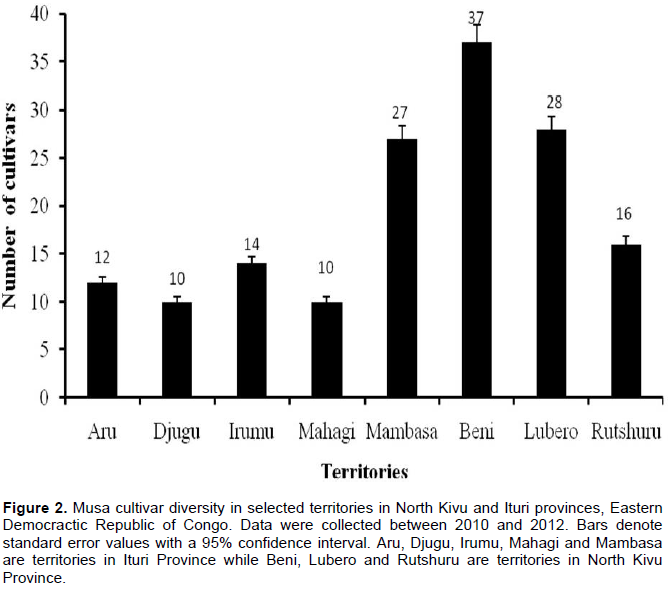
Musa diversity by use groups
Across the two provinces, 76.6% of the Musa cultivars were processed through cooking. These predominantly included the plantain (AAB genome) types (52% of the cultivars across the sites) and the green cooking East African Highland banana (Mutika and Lujugira sub-groups) cultivars that accounted for 23.3% of the cultivars identified. The other cooking cultivar identified in the study was ‘Bluggoe’ (ABB genome). The beer cultivars accounted for 11.7% of the cultivars. These beer cultivars included ‘Pisang Awak’ (ABB genome), four East African Highland banana cultivars (AAA genome) and ‘Yangambi Km5’ (AAA genome). The dessert types (11.7% of cultivars) included ‘Gros Michel’ (AAA genome) and its variants, dwarf and giant Cavendish (AAA genome) types and ‘Ney povan’ (AAA-genome).
Presumed new cultivars encountered and sampled
Many presumably new banana and plantain cultivars were collected for further characterization and conservation at the UCG Musa collection at Butembo, North Kivu Province, Eastern DR Congo. A total of six cultivars including four plantains (‘Alambi’, ‘Akange’, ‘Bakpulu’ and ‘Ngwende’), one dessert (later identified as ‘Gros Michel II’, because of its similarity to ‘Gros Michel’) and one cooking banana (‘Sira’ AAA-EA) were sampled from Ituri Province. A total of 13 cultivars comprising four plantains (‘UCG 15’, ‘Kirisirya’ Plantain, ‘UCG 8’, ‘Kingulungulu’), three dessert banana types (‘Banana noire’ (AAB), ‘Mbogoya’ (AAA, sny. ‘Gros Michel’), ‘Giant banana’ (AAA)); four cooking cultivars (‘Bwazirume’, ‘Bagore bararume’, ‘UCG 10’, ‘UCG 7’) and two beer cultivars (‘Pakuma II’ (AAA-EA) and ‘Nyamabere’ (AAA-EA)) were also collected from North Kivu Province. At least four suckers for each of the above sampled cultivars were collected and planted in the ex situ Musa genebank collection of the UCG for further characterisation and conservation. The location of the cultivars collected during the study and the presumed new cultivars are shown in Figure 3.
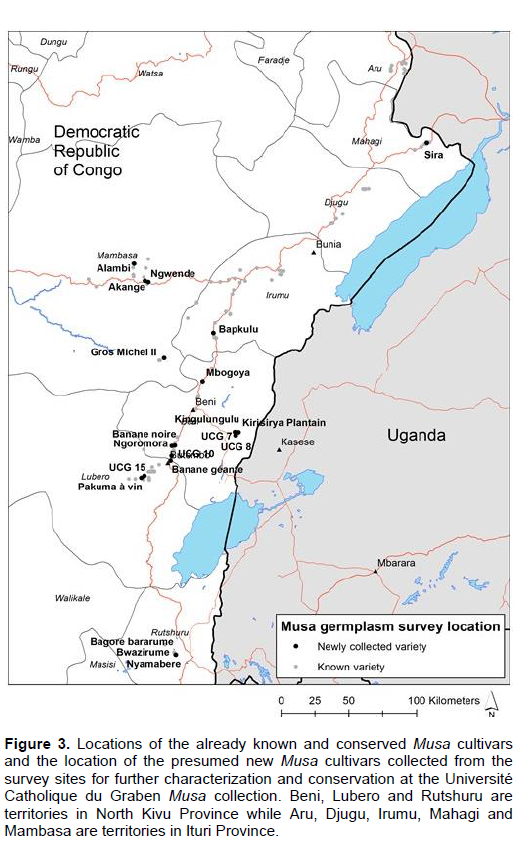
Musa cultivar synonyms in North Kivu and Ituri provinces
Musa cultivars were given a variety of names in the different languages and dialects (Table 3). The two provinces are home to over 17 tribes with different languages and dialects (Maindo, 2003; DRC, Ministry of Planning, 2005; Saint Moulin, 2006). In this study, a total of 76 cultivar names are listed across the study sites for 22 cultivars. Through the experience of the germplasm curator (six years of experience), synonyms within each region were identified, narrowing the overall cultivar list to 61 cultivars (Table 1). The presence of synonyms in different languages, dialects and countries is a common problem confronting banana taxonomists (Valmayor et al., 2000). The knowledge of synonyms prevents wasteful duplication of basic studies on banana cultivars and promotes regional understanding, communication and banana trade (Valmayor et al., 2000). More synonyms, however, probably exist among the listed 61 cultivars. Coupling molecular approaches that are efficient in elucidating the genetic relationships among species to the morphological characterisation approaches to minimize the confusion due to synonyms is recommended. In addition, the level of genetic variation among the cultivars needs to be elucidated.
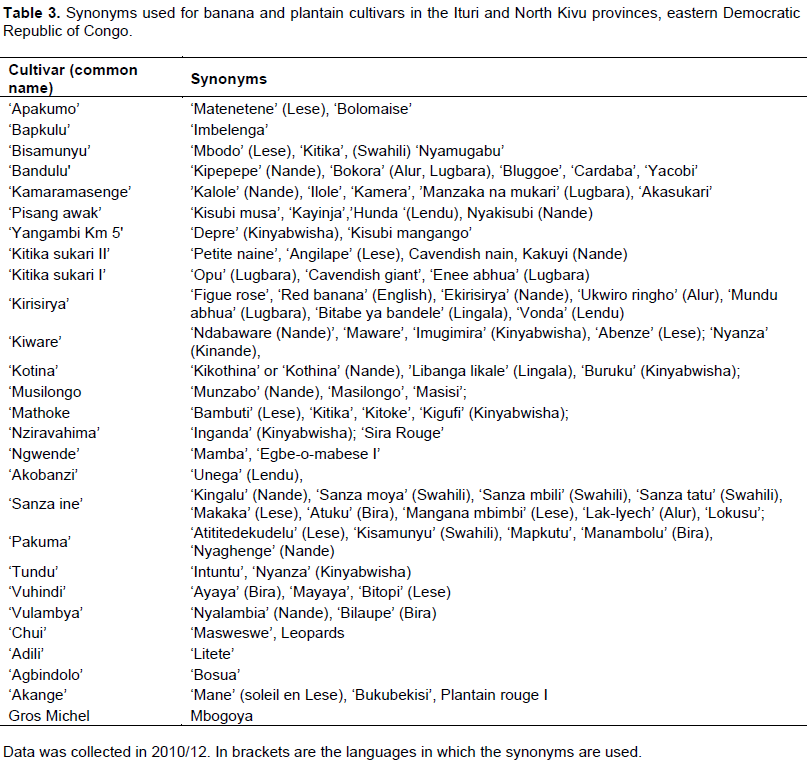
Morphological characterization of Musa cultivars across the study regions
Simmonds (1962) established that morphological characterization of bananas is the principal way to classify banana cultivars into different genomic groups. A total of 34-minimum set of descriptors have been developed for characterising banana (IPGRI-INIBAP/CIRAD, 1996; MusaNet, 2011) (Table 4). Twenty three out of these 34 descriptors were used for discriminating and grouping the Musa cultivars identified across the study regions (Table 4). The 23 descriptors were found to be more discriminating and therefore used for the final grouping of the cultivars in these regions. In a similar study, Karamura et al. (2013) used 25 of the 34 minimum descriptors for characterization of Musa clones (from mixed genome groups) as the other seven descriptors were unable to differentiate between the clones.
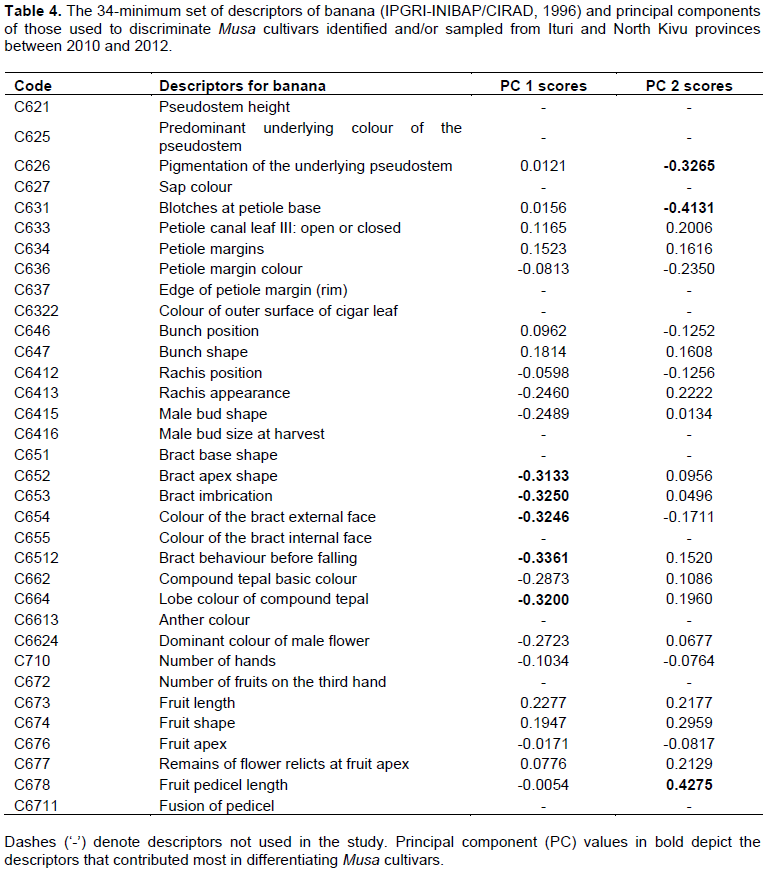
The first two principal components (PCs) following a principal component analysis explained 42% of the variaion, while together with the third PC they accounted for 52%. The variation in PC1 was mainly explained by the male bud bract characteristics, while in PC2 by the fruit pedicel length (C678), the blotches at the petiole base (C631) and the pigmententation of the underlying pseudostem (C626) (Table 4). The plot of PC1 and PC2 for the 61 Musa cultivars (after removing synonyms) resulted in three major clusters (Figure 4). The first cluster comprised the French plantains that are characterised by the presence of a complete male inflorescence. The second cluster was composed of the false horn and horn plantains (AAB) that are, respectively, characterised by a reduced and an absent male infloresence part and, in some cases, relatively few hands. The third cluster comprised varieties that had a complete inflorescence, being a mixture of cooking and beer East African Highland bananas (AAA-EA genome). Most of the dessert cultivars (AAA-genome) grouped with the East African Highland types, with a few grouping between the East African Highland types and the French plantains and one dessert variety grouping with the French types. The ABB-genome clustered within the French plantains (Figure 4).
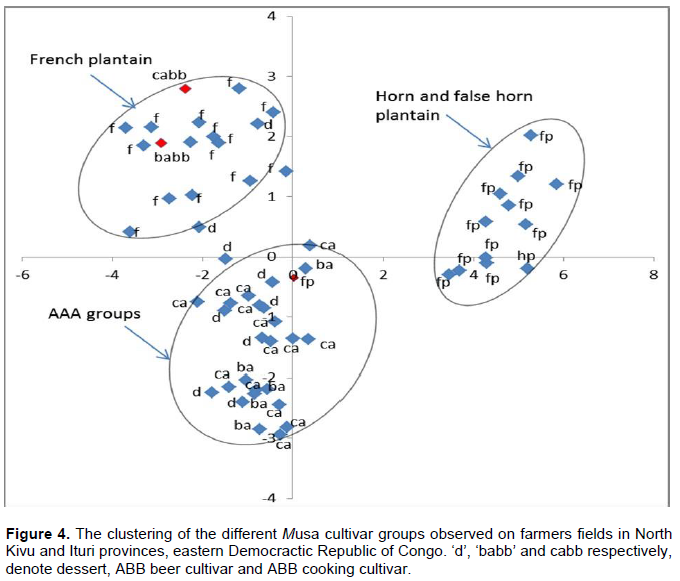
Cultivar similarity between territories in Ituri and North-Kivu provinces
The Morisita similarity index between Ituri and North Kivu province territories was less than 0.5 (Figure 5). This suggests a dissimilarity among the cultivars recorded in the territories of Ituri and those recorded in North Kivu. However, similarity was recorded (Morisita index: 0.55) in the diversity of cultivars in the territories within North Kivu (Figure 5). This could be explained by the similarity in the agro-ecologies in these territories. Within North Kivu, a higher similarity (Morisita index: 0.90) was observed between Beni and Lubero territories. This could be attributed to the fact that Beni (1057 to 1974 m a.s.l.) and Lubero (1348 to 1847 m a.s.l.) are similar in their agro-ecologies. In addition, these territories share a common border that possibly allows for free exchange of Musa germplasm (Figures 1 and 3). In contrast, Rutshuru is separated from these territories by the Virunga National Park and borders Uganda and Rwanda, with a possible influence of these two countries on its cultivar composition (Figures 1 and 2). For example, in a Musa expedition in Ugandan districts bordering Eastern DR Congo, Karamura et al. (2013) noted a mixed Uganda–DR Congo Musa composition. Several names of both plantains and the highland bananas were associated with dialects across both Uganda and DR Congo. For example, ‘Nyalambya’/‘Nyarambi’ in Uganda (called ‘Vulambya’ in North Kivu), ‘Ndyabawali’ in Uganda (called ‘Kiware’ or ‘Maware’ in North Kivu), plantain ‘Namutobisho’ in Bundibugyo, Uganda (called ‘Vuhindi’ in North Kivu) are widely grown in both Uganda and Eastern DR Congo. Karamura et al. (2013) attributed this border Musa composition to the similar border ecologies, ethnic groups and ethnic migrations across the borders.
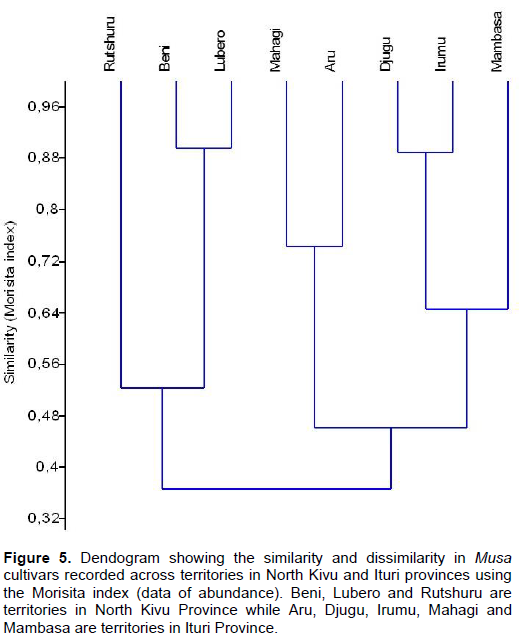
On the other hand, dissimilarity was observed in territories within the province of Ituri (Figure 5). Mahagi and Aru territories were observed to form a separate cluster from Djugu, Irumu and Mambasa that formed another cluster. Djugu and Irumu were further observed to have a high similarity (Morisita index: 0.88) (Figure 5). Mahagi (1616 to 1884 m a.s.l.) and Aru (1158 to 1456 m a.s.l) share similar agro-ecologies and a common border, that possibly allows for easy exchange of Musa germplasm. Djugu (1434 to 1740 m a.s.l.) and Irumu (864 to 1118 m a.s.l) territories, though variable in altitude, share a common border. Mambasa on the other hand, has a low altitude (851 to 1008 m a.s.l) which is like that in Irumu (864 to 1118 m a.s.l), thus permitting growth of similar Musa cultivars. Additionally, Mambasa and Irumu territories share a common border (Figure 3).
Musa cultivar erosion
Across the study sites only six Musa cultivars were perceived by farmers to be under threat of genetic erosion or to have been eroded (Table 5). However, this was only perceived by between 2 and 8% of respondents in Ituri and North Kivu, respectively. Only two of these cultivars (‘Kirisirya’ and ‘Pakuma’) were reported to be threatened across the study sites. Customary beliefs such as cultivar restriction to/consumption by women or the elderly were some of the reasons for the perceived threat or erosion of the cultivars. Other reasons included varietal degeneration (small size of banana fruits), low preference by farmers and vulnerability to XW (Table 5).

Low farmer preference for cultivars has been reported to influence the selection of cultivars maintained on farm and hence their diversity in Burundi and Rwanda (Ocimati et al., 2013b, 2014). Pests and diseases, especially XW, Fusarium wilt and Bunchy Top Disease (BBTD), have also been cited as responsible for the erosion of Musa cultivars in Burundi, Rwanda and Uganda (Okech et al., 2005; Karamura et al., 2013; Ocimati et al., 2013b, 2014). The banana crop has also been abandoned in XW-affected sites in, for example, Uganda and parts of Eastern DR Congo, in favour of alternatives such as sweet potato, taro, legumes and cassava (Karamura et al., 2006; Kalyebara et al., 2007; Ocimati et al., 2016a, b). Musa conservation strategies need to integrate the management of diseases such as XW and BBTD that are fast spreading and indescriminately affecting the Musa crop in the region. The threatened cultivars in this study were collected and planted in the Musa germplasm collection at Université Catholique du Graben (UCG).
CONCLUSION AND RECOMMENDATIONS
This study revealed a high diversity of plantains (Musa AAB) and East African Highland bananas (Musa AAA) in both the North Kivu and Ituri provinces. Only a few cultivars (6) were reportedly at risk of erosion. However, the increasing burden of pests and diseases could negatively impact on this rich diversity. Efforts are therefore needed to manage and minimise the impact of these diseases on farm. Planting of these cultivars in the in-situ collection at Butembo is a positive step towards conservation and further evaluation of these cultivars. These cultivars could also be duplicated in other collections in the country and the international Musa spp. collection at the International Transit Center, Leuven, Belgium. Expanding this Musa germplasm collection expedition to cover the entire Eastern DR Congo is recommended to have a picture of the whole Musa diversity. Robust molecular characterization techniques need to be used to further understand the genetic base and diversity of these cultivars.
The authors have not declared any conflict of interests.
REFERENCES
|
Bakelana K, Ndungo V (2004). La maladie de Bwere: une bactériose dévastatrice de la culture de la banane dans la province du Nord Kivu en République Démocratique du Congo, Rapport de mission FAO, 1pp.
|
|
|
|
Doré C, Varoquaux F (2006). Histoire et amélioration de cinquante plantes cultivées, INRA, édition Savoir faire, Paris, France, 812p.
|
|
|
|
|
Food and Agriculture Organization (FAO) (2010). Enquête sur les maladies des bananiers et bananiers plantains: BBTD et BXW dans la province de l'Ituri, collaboration avec faculté des sciences agronomiques de l'UCG, 25p.
|
|
|
|
|
Frison EA, Sharrock S (1999). The economic, social and nutritional importance of banana in the world. In: Bananas and food security/Les productions bananières: un enjeu économique majeur pour la sécurité alimentaire. International symposium, Douala, Cameroun, 10-14 November 1988. INIBAP, Montpellier, France
|
|
|
|
|
Gaidashova SV, Okech SHO, Gold CS, Nyagahungu I (2005). Why beer bananas? The case for Rwanda. Agricultural Policy. InfoMusa 14(1):2-6.
|
|
|
|
|
Hammer O, Harper DAT, Ryan PD (2008). Logiciel Past: Palaeontological Statistica ver.1.77 (Available at:
View).
|
|
|
|
|
Hammer O, Harper DAT, Ryan PD (2001). PAST: Paleontological Statistics Software Package for Education and Data Analysis. Palaeontol. Electron. 4(1):9.
|
|
|
|
|
International Plant Genetic Resources Institute-International Network for the Improvement of Banana and Plantain/Agricultural Research Centre for International Development (IPGRI-INIBAP/CIRAD) (1996). Descriptors for bananas (Musa spp.), Montpellier, France.
View
|
|
|
|
|
Karamura E, Kayobyo G, Blomme G, Benin S, Eden-Green SJ, Markham R (2006). Impacts of BXW epidemic on the livelihoods of rural communities in Uganda. Proceedings of the 4th International Bacterial Wilt Symposium, 17-20 July 2006, Central Science Laboratory, York, UK. P. 57.
|
|
|
|
|
Karamura D, Ocimati W, Ssali R, Jogo W, Walyawula S, Karamura E (2013). Banana genotype composition along the Uganda-Democratic Republic of Congo border: a gene pool mix for plantain and highland bananas. In: Blomme, G. et al., (eds): Banana systems in the humid highlands of sub-Saharan Africa: enhancing resilience and productivity. CAB International (UK). pp. 22-29.
Crossref
|
|
|
|
|
Kalyebara R, Wood S, Abodi PM (2007). Assessing the potential impact of selected technologies on the banana industry in Uganda. In: Smale, M., Tushemereirwe, W.K. (eds.): An Economic Assessment of Banana Genetic Improvement and Innovation in the Lake Victoria Region of Uganda and Tanzania. IFPRI Research Report 155. Washington, DC, USA: IFPRI, pp. 141-156.
|
|
|
|
|
Kitavi M, Downing T, Lorenzen J, Karamura D, Onyango M, Nyine M, Ferguson M, Spillane C (2016). The triploid East African Highland banana (EAHB) genepool is genetically uniform arising from a single ancestral clone that underwent population expansion by vegetative propagation. Theor. Appl. Genet. 129:547-561.
Crossref
|
|
|
|
|
Maindo MN (2003). La républiquette de l'Ituri en République Démocratique du Congo: Un Far West ougandais. Politique Africaine 89:181-192.
Crossref
|
|
|
|
|
Morisita M (1959). Measuring of interspecific association and similarity between communities. Memoirs of the Faculty of Science, Kyushu University, Series E (Biology) 3:65-80.
|
|
|
|
|
MusaNet (2011). MusaNet strategic meeting; documents and presentations; 28 February-3 March 2011, Montpellier, France. Available at: http://www.crop-diversity.org/banana/MusaNet//Presentations/11-Day2-Horry-Presentation.pdf (accessed 23 October 2012).
|
|
|
|
|
Ndungo V (2002) Analyse de la sécurité alimentaire menacée en période de guerre dans les territoires de Beni et de Lubero. Parcours et initiatives no 01, CRIG/UCG, pp. 89-95.
|
|
|
|
|
Ndungo V (2004). La menace de la fusariose sur la production des bananiers et plantains dans les pays des grands lacs Africains (Burundi, RDC, Rwanda). Parcours et initiatives n°3, CRIG/UCG Butembo, pp. 30-34.
|
|
|
|
|
Ndungo V, Komi F, Mwangi M (2008). Banana Xanthomonas wilt in the DR Congo: impact, spread and management. J. Appl. Biosci. 1:1-7.
|
|
|
|
|
Noyer JL, Causse S, Tomekpe K, Bouet A, Baurens FC (2005). A new image of plantain diversity assessed by SSR, AFLP and MSAP markers. Genetica 124:61-69.
Crossref
|
|
|
|
|
Nsabimana A., Van Staden J (2005). Characterization of the banana germplasm collection from Rubona-Rwanda. Sci. Hort. 107:58-63.
Crossref
|
|
|
|
|
Ocimati W, Blomme G, Karamura D, Ragama P, Lepoint P, Kanyaruguru JP, Ngezahayo F, Ndungo V, Hakizimana F (2013a). On-farm Musa germplasm diversity in different agroecologies of Burundi. Int. J. Biodivers. Conserv. 5:751-760.
|
|
|
|
|
Ocimati W, Groot JCJ, Ntamwira J, Bahati L, Tittonell PA, Taulya G, Bumba M, Amin D, Blomme G (2016a). Land use/cropping pattern changes in retrospect across Xanthomonas wilt-infected landscapes. Abstracts for X International Symposium on Banana/ISHS-ProMusa symposium on Agroecological approaches to promote innovative banana production systems, Montpellier, France – 10-14 October 2016 (http://ishs-promusa2016.cirad.fr). Book of abstracts, P 72.
|
|
|
|
|
Ocimati W, Groot JC, Tittonell P, Blomme G (2016b). Effects of banana Xanthomonas wilt and other banana diseases on ecosystem services in banana based agroecosystems. Abstracts for X International Symposium on Banana/ISHS-ProMusa symposium on Agroecological approaches to promote innovative banana production systems, Montpellier, France – 10-14 October 2016 (http://ishs-promusa2016.cirad.fr). Book of abstracts, P 14.
|
|
|
|
|
Ocimati W, Karamura D, Rutikanga A, Sivirihauma C, Ndungo V, Adheka J, Dhed'a B, Muhindo H, Ntamwira J, Hakizimana S, Ngezahayo F, Ragama P, Lepoint P, Kanyaruguru J-P, De Langhe E, Gaidashova SV, Nsabimana A, Murekezi C, Blomme G (2013b). Musa germplasm diversity status across a wide range of agro-ecological zones in Rwanda, Burundi and eastern Democratic Republic of Congo. In: Blomme, G. et al. (eds): Banana systems in the humid highlands of Sub-Saharan Africa: enhancing resilience and productivity. CAB Int (UK), pp. 8-21.
Crossref
|
|
|
|
|
Ocimati W, Blomme G, Rutikanga A, Karamura D, Ragama P, Gaidashova S, Nsabimana A, Murekezi C (2014). Musa germplasm diversity status across a wide range of agro-ecological zones in Rwanda. J. Appl. Biosci. 73:5979-5990.
|
|
|
|
|
Okech SHO, Gaidashova SV, Gold CS, Gatarayiha C, Ragama P (2002). Banana pests and diseases in Rwanda: a participatory rural appraisal and diagnostic survey observations. In: Tenywa, J.S., Nampala, M.P., Kyamanywa, S. and Osiru, M. (eds.). Proceedings of the Integrated Pest Management Symposium, 8 to 12 September 2002, Kampala. NARO/Makerere University, Kampala, Uganda, pp. 162-167.
|
|
|
|
|
Okech SHO, Gaidashova SV, Gold CS, Nyagahungu I, Musumbu JT (2005). The influence of socio-economic and marketing factors on banana production in Rwanda: results from a participatory rural appraisal. Int. J. Sust. Dev. World Ecol. 12:149-160.
Crossref
|
|
|
|
|
Ortiz R, Vuylsteke D, Dumpe B, Ferris RSB (1995). Banana weevil resistance and corm hardness in Musa germplasm. Euphytica 86:95-102.
Crossref
|
|
|
|
|
République Démocratique du Congo, Ministère du Plan, Comité Provincial (CP-SRP) (2005). DSRP, Consultations participatives sur la pauvreté auprès des communautés de base en Province du Nord-Kivu, Rapport final, 53p.
|
|
|
|
|
Robinson JC, Galán Saúco V (2010). Bananas and Plantains. 2nd edn. CAB International, Wallingford, UK.
Crossref
|
|
|
|
|
Rohlf FJ (2009). Numerical Taxonomy and Multivariate Analysis System version 2.21. Applied Biostatistics Inc, Exeter Software.
|
|
|
|
|
Saint Moulin LZ (2006). Atlas de l'organisation administrative de la République Démocratique du Congo, Cepas-Kinshasa, pp.102-106.
|
|
|
|
|
Sebasigari K (1985). Overview of banana cultivation and constraints in the Economic Community of the Great Lakes States (CEPGL). In: Kirby, R. and Ngendahayo, D. (eds), Banana production and research in eastern and central Africa. Proceedings of a Regional Workshop held in Bujumbura, Burundi 14-17 December 1983. IRAZ/IDRC. IDRC-MR114e, pp. 9-22.
|
|
|
|
|
Simmonds NW (1962). The evolution of the bananas. Longman, London, UK.
|
|
|
|
|
Swennen R, Vuylsteke D, Ortiz R (1995). Phenotypic diversity and patterns of variation in West and Central African plantains (Musa spp., AAB group, Musaceae). Econ. Bot. 49:320-327.
Crossref
|
|
|
|
|
Tezenas DM (1990). Atlas de l'organisation administrative de la Répulique démocratique du Congo:(fonds de plan de l'Institut géographique du Congo). Centre d'études pour l'action sociale, pp. 211-218.
|
|
|
|
|
Valmayor RV, Jamaluddin SH, Silayoi B, Kusumo S, Danh LD, Pascua OC, Espino RRC (2000). Banana Cultivar Names and Synonyms in Southeast Asia. International Network for the Improvement of Banana and Plantain (INIBAP), Asia and the Pacific Office, Los Ba-os, Laguna, Philippines.
|
|
|
|
|
Vuylsteke D, Ortiz R, Ferris RSB, Swennen R (1995). PITA-9: A black sigatoka resistant hybrid from the 'False Horn' plantain gene pool. Hort. Sci. 30:395-397.
|
|
|
|
|
Wilkie DS (1987). Impact of Swidden Agriculture and Subsistence Hunting on Diversity and Abundance of Exploited Fauna in the Ituri Forest of Northeastern Zaire. Ph.D. dissertation, Department of Forestry and Wildlife Management, University of Massachusetts.
|
|
|
|
|
Wolda H (1981). Similarity indices, sample size and diversity. Oecologia 50:296-302.
Crossref
|
|










